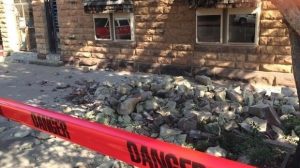3 May 2017–Changes to the rate of wastewater injection in disposal wells may have contributed to conditions that led to last year’s Pawnee earthquake in Oklahoma, according to a new report published May 3 as part of a focus section in Seismological Research Letters.

The magnitude 5.8 Pawnee quake, felt widely across Oklahoma, is the largest earthquake recorded in the state since the 1950s. Most Oklahoma earthquakes since 2009 are thought to have been triggered by wastewater produced by oil and gas drilling that has been injected back into the ground. The Pawnee earthquake occurred in a region with active wastewater disposal wells, and is potentially the largest such induced earthquake to have occurred in Oklahoma so far, write University of Oklahoma seismologists Xiaowei Chen and Norimitsu Nakata in their preface to the section.
When Andrew Barbour of the U.S. Geological Survey and colleagues examined new injection data from nearby disposal wells in Osage County, they found a significant increase in injection rates in the years leading up to the Pawnee mainshock. Some wells injected wastewater at a constant rate, while others injected the water at a variable rate. The overall injected volume was roughly the same between these two types of wells.
Barbour and colleagues’ models of injection indicate, however, that it may have been the variable-rate wells that were most important for the Pawnee event. Their findings suggest that “long-term injection may have been responsible for a gradual loading of the fault to the point where it primed the fault for failure triggered by the short-term high-rate injection…” the authors write. They note that in the absence of these variable rate injections, however, the fault may have still failed at a much later time.
Other papers in the Pawnee special focus section include:
· Raphaël Grandin and colleagues at the Institut de Physique du Globe de Paris combined satellite radar data (InSAR) and broadband seismic data to determine that the main Pawnee seismic rupture occurred between 4 and 9 kilometers depth, well below the main sediment layer where wastewater is injected. Since the fault that was activated in the Pawnee event was unknown before, the researchers say the future risk of a magnitude 6 event triggered by fluid injection “remains an open question.”
· Fred Pollitz of the U.S. Geological Survey and colleagues combined InSAR, GPS and other data, and Eric Fielding of Jet Propulsion Laboratory and colleagues used InSAR and seismic data to develop models of fault slip and take a closer look at surface changes from the Pawnee quake. Fielding and colleagues confirmed that there was no significant evidence of a surface rupture from the quake, while Pollitz and colleagues found signs of fault zone collapse around an area of high slip on the fault. They suggest the collapse might represent compaction of cracks in the rock that developed during the fault rupture, as fluids migrated away from the fault zone.
· Kayla Kroll of Lawrence Livermore National Laboratory and colleagues report their observations of water level changes in two monitoring wells in response to the Pawnee quake and to the November 2016 magnitude 5.0 Cushing earthquake. Fluid levels rose with the Pawnee quake and lowered slightly with the Cushing quake, indicating that the Pawnee earthquake especially altered the fluid flow through regional rock layers up to 50 kilometers from the Pawnee mainshock. In another paper by Chi-Yuen Wang of UC Berkeley
and colleagues, the researchers note that enhanced permeability of regional rock may be behind changes to groundwater levels up to 150 kilometers from the Pawnee epicenter.
· The Pawnee quake produced a variety of ground surface liquefaction features, such as fractures, sand blows and ground spreading and subsidence. Folarin Kolawole of Oklahoma State University and colleagues have made the first comprehensive observations of those features with a “CAT scan”-style technology called high resolution electrical resistivity tomography (ERT).
· An analysis of foreshock activity by Jacob Walter of the Oklahoma Geological Survey and colleagues demonstrates a gradual fault stress increase in the months prior to the Pawnee mainshock. Colin Pennington and Xiaowei Chen of the University of Oklahoma investigated stress interactions between the main faults in the area, concluding that the three Pawnee foreshocks promoted the failure of the fault for the Pawnee mainshock and early aftershock, and that the mainshock led to the fault failure behind further aftershocks.
· Stress parameters for the Pawnee and two other Oklahoma earthquakes are similar to those estimated for other potentially induced earthquakes in the central and southern U.S., and to shallow natural earthquakes,
according to a paper by Chris Cramer of the University of Memphis. Stress parameters measure the difference in stress across a fault before and after an earthquake.
